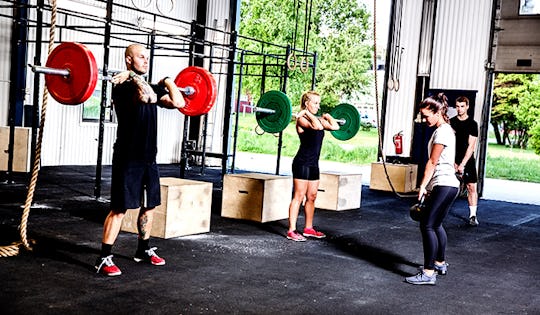CrossFit is wonderful. CrossFit is repulsive. CrossFit is, well, CrossFit. With the sport now sponsored by Reebok and appearing on ESPN, more people are putting it into practice. Is it a savior? Or is it a destroyer of worlds? Most likely, both.
From an outsider “non-athlete” perspective, there are two options for someone interested in fitness: become a meathead weightlifter or become a spandex wearing cardio bunny. CrossFit, however, bridges the gap.
Reason #1: Crossfit is Bridging the Fitness Gap
Really, I’m not sure how. Both Olympic Weightlifting and Powerlifting have existed for decades. No one cared to get involved with either individually. But combined together with some extra flare, they are feasted over.
This is part of the good, the very good. Instead of new fitness folks sitting on machines and slopping around on treadmills, they are moving their body through space with intensity by squatting, pressing, pulling, toying around on gymnastics rings, running on *gasp* actual ground, and doing a bunch of other “good” things.
Another great aspect of CrossFit is the camaraderie. The athletes motivate each other, regularly giving competitors high-fives mid competition. It builds caring relationships.
But that’s about where CrossFit tails. It’s branded as creating the “fittest on earth,” but “fit” is an arbitrary word. What’s “fit” for a Marathon Runner isn’t “fit” for an Olympic Weightlifter. What’s “fit” for CrossFit is “fit” for, well, CrossFit. Nothing else, and that’s a distinction everyone needs to embrace.
CrossFit started as a training method—a few exercises written on a white board daily. But since then, it has become a sport in itself.
Barbells save space and money, making it an ideal piece of equipment for a fitness enthusiast. Few facilities come equipped with 400m tracks. The world is moving away from running and moving towards lifting. But barbell-centralized sports are comparable to track and field events.
Olympic Weightlifting involves a short, explosive, intense burst of energy. This is the high jump, long jump, and whatnot.
Powerlifting involves longer (yet still intense), explosive, bursts of energy. This is the 100m and 400m. CrossFit involves longer, less intense, bursts of energy. This is the 800m and 1600m.
Reason #2: Crossfit Is Its Own Sport
CrossFit is its own “event” in the grand scheme of barbell sports. Now, all sports risk injury, but because of CrossFit’s nature—doing highly technical skills for high repetitions over time—the risk of injury is higher.
It’s shooting free throws in basketball. Olympic Weightlifting is like putting two minutes on the clock and shooting one shot. You can focus. You can dial in on mechanics.
You can think things through. But CrossFit is like putting two minutes on the clock and trying to make as many as you can. You don’t focus. Your mechanics get ugly. You don’t think. You just do.
So, CrossFitters pull with bad mechanics. They ignore proper form, and truly, that’s OK as long as they accept the inherent risk.
The big issue with CrossFit is that it positions itself as a training method that anyone can hop into. But remember, CrossFit is a sport. Saying you do CrossFit is just like saying you play football.
CrossFit is the end, not the means to the end. Most sports use barbells and other training devices to get better at their sport. But using CrossFit to get better at another sport is like playing basketball to get better at tennis.
Reason #3: Crossfit Isn’t One Size Fits All
You don’t use CrossFit to “condition” for football (sorry). Every sport has its own energy system demand. We’re quick to lump “conditioning” into one category. But saying you’re “conditioning” is like saying you’re “lifting weights.”
Well, why are you lifting weights? Maximal Strength? Power? Endurance? Strength-Speed? Starting Strength? Strength-Endurance? I could go on and on with different strength and power qualities that can all be obtained from “lifting weights.”
Using the word “conditioning” is just as arbitrary. Huffing and puffing doesn’t mean you’re “conditioning.” There are energy system demands in every sport that need to be considered. Football, for instance, has a high alactic anaerobic component (fancy words, I know) as each play lasts about six-or-less seconds.
Because this has to be repeated over the length of the game, it taxes both the outright power of the system and how long the power can be sustained over time (also known as capacity).
Contrary to popular belief, the aerobic system plays an important role in the capacity aspect. So good old American Football is a sport rooted in the alactic anaerobic and aerobic energy systems.
As a quick refresher, there are two main energy designations but three main energy pathways. There’s the anaerobic system (without oxygen), and aerobic system (with oxygen). The anaerobic system, however, is further broken down into the alactic (ATP-PC) and lactic (glycolytic) branches.
Reason #4: Crossfit Is Without Direction (WOD)
Just because an activity is “anaerobic” doesn’t mean it fits all sizes. Most times, CrossFit falls under the anaerobic lactic and aerobic pathways.
CrossFit isn’t designed to hit specific energy systems for specific sports. In fact, CrossFit isn’t designed. Period. The workouts are random.
So if you’re a football player looking to be better suited to play your sport, doing CrossFit is like reaching into a hat and hoping to pull out a good number (and you do that every day). It’s better to pick a sensible program that specifically tailors to your sporting goals.
Reason #5: Crossfit is Bringing Back Intensity
CrossFitters are said to be a part of a cult, and few realize why such passion exists. But CrossFit athletes, in general, train with a lot of intensity. They give so much effort that it becomes a spiritual experience.
It takes a certain mentality to push through comfort barriers, and when the person next to you is doing the same, it forms strong bonds—similar to, “I feel your pain.”
This isn’t too good if you’re pushing through dangerous situations that have high potential for injury, but to fall in love with training to the point of working as hard as they do is something to behold.
While I personally would never follow a “WOD,” I think everyone needs to extrapolate the overriding principles of CrossFit. Here are my thoughts on the subject:
Principles of Crossfit
Train major compound lifts using a barbell.
- Move your bodyweight through space.
- Run here and there.
- Get good at many motor abilities.
- Do things that make you huff and puff once in a while.
- Do things that push your mental limits once in a while.
- Hanging from rings isn’t optional.
- Learn how to properly do the Olympic lifts.
- Fall in love with training.
If these principles weren’t attacked randomly, I’d say that these are things the vast majority of us—be it athlete or general fitness enthusiast— should be doing.
CrossFit has its ups, just as it has its downs. It’s not “right” or “wrong” to enjoy the sport. Just know that it isn’t the answer to everything and that it is its own separate entity. Do that, and everything should work out just fine



)





